Porterhouse Steak Recipe (Tuscan Style)
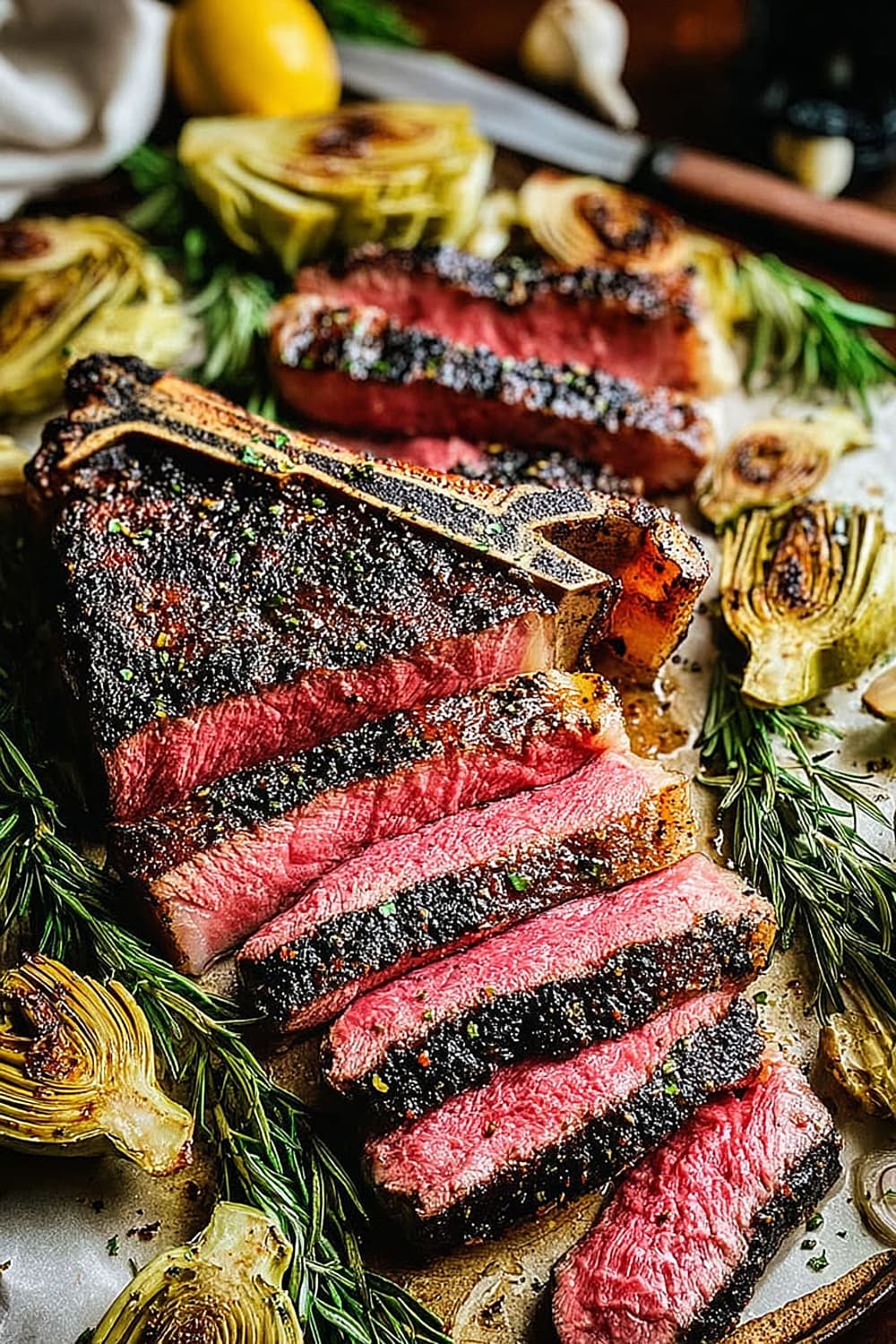
This porterhouse steak recipe is basically the culinary equivalent of wearing a tuxedo to a barbecue – completely over the top and absolutely worth it.
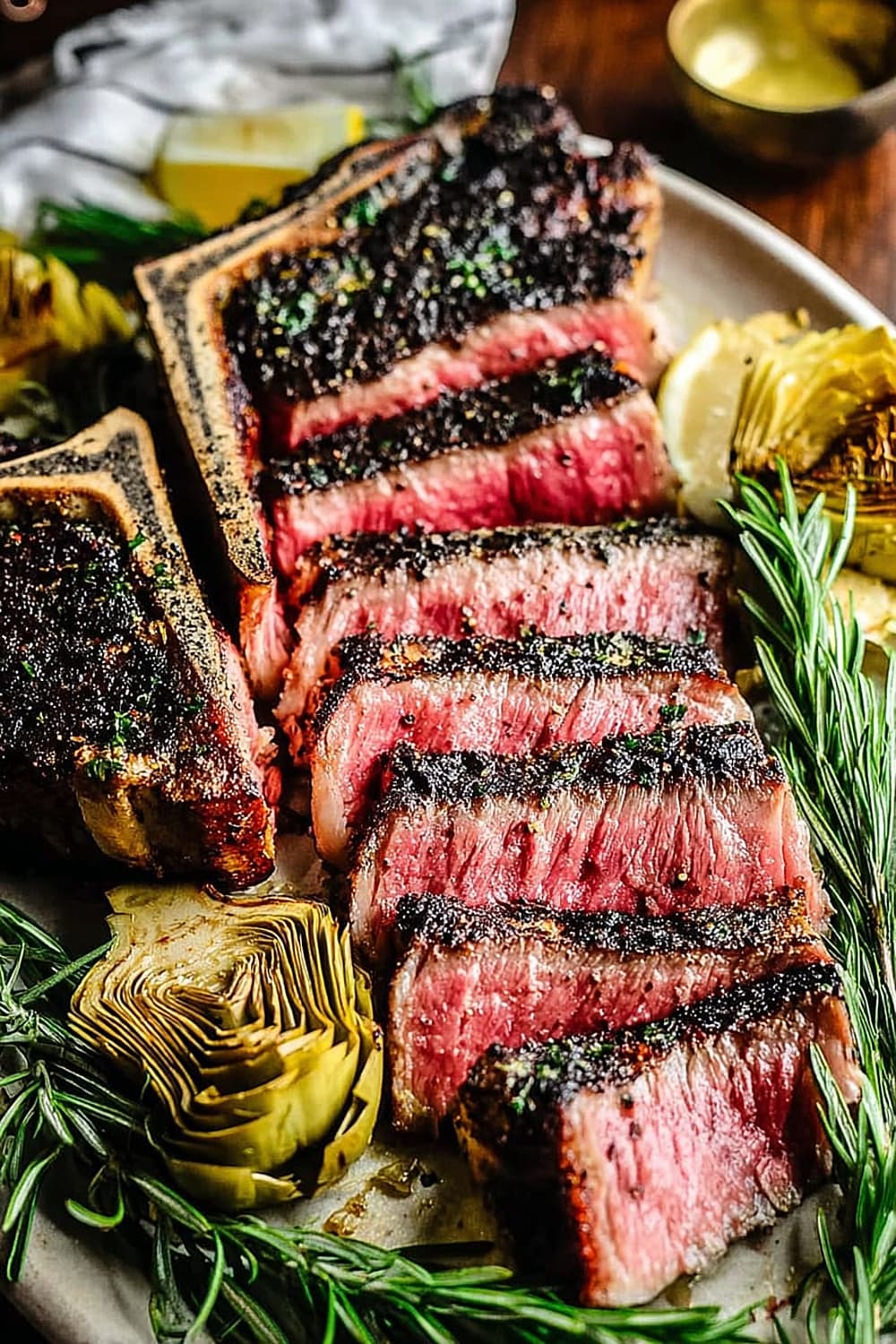
Picture this: a massive 32-ounce porterhouse getting a Mediterranean spa treatment with fresh herbs, garlic, and olive oil, then emerging from your grill with a crust so perfect it should have its own Instagram account.
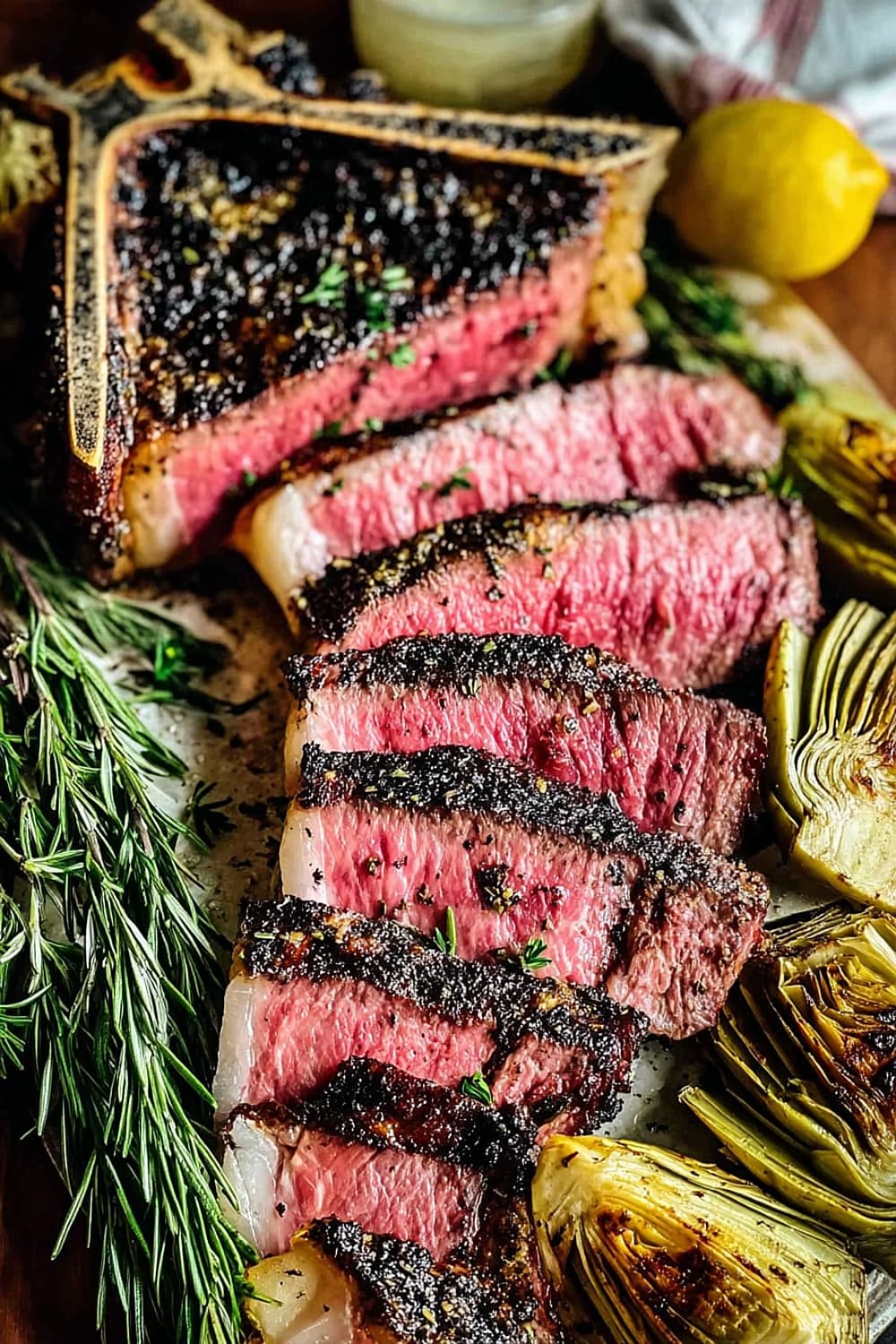
The Tuscan-style marinade transforms this already impressive cut into something that’ll have your neighbors mysteriously appearing at your fence right around dinner time.
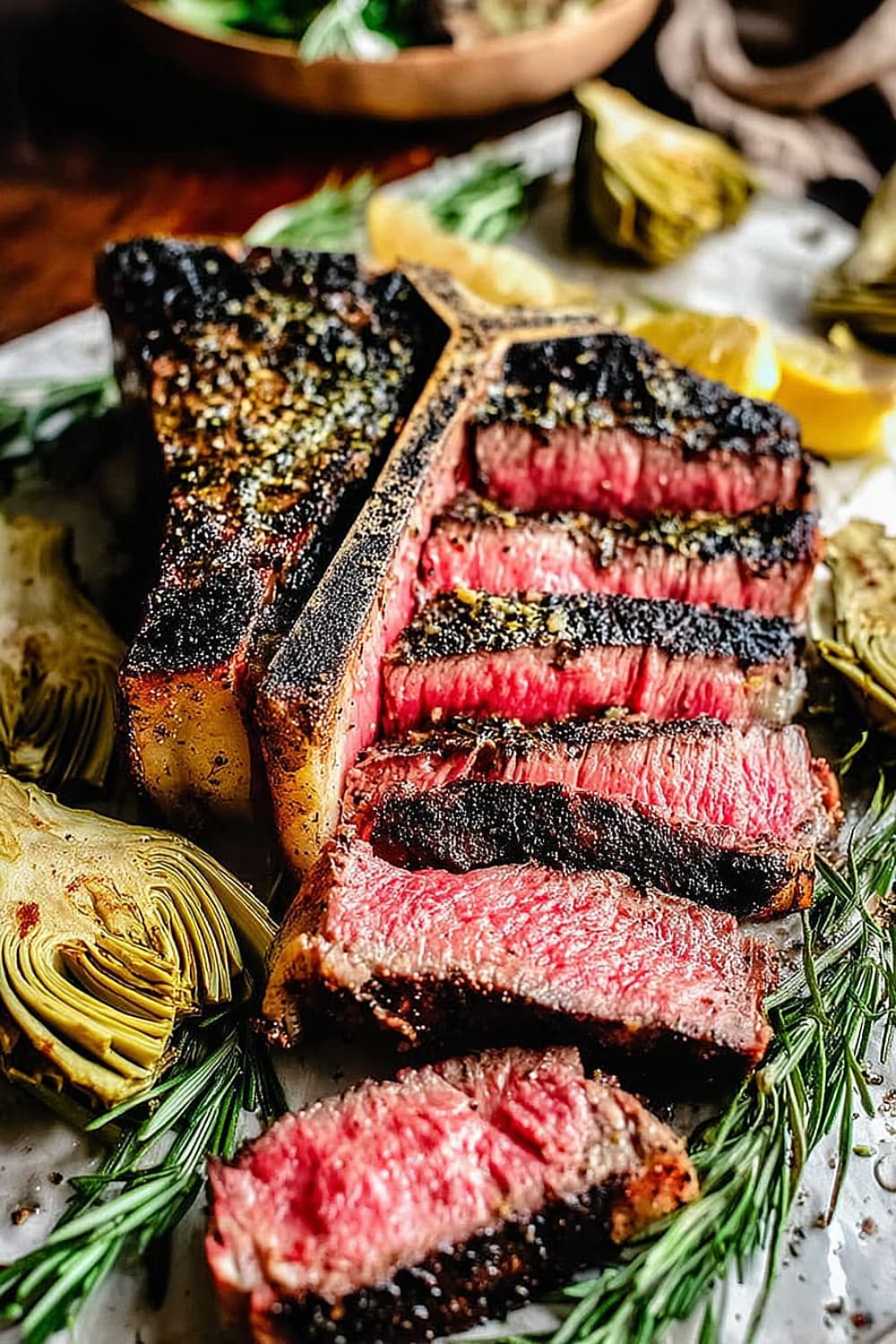
We’re talking about a steak that’s tender enough to cut with a fork but with enough char to satisfy your inner caveman – it’s the best of both worlds without requiring a culinary degree.
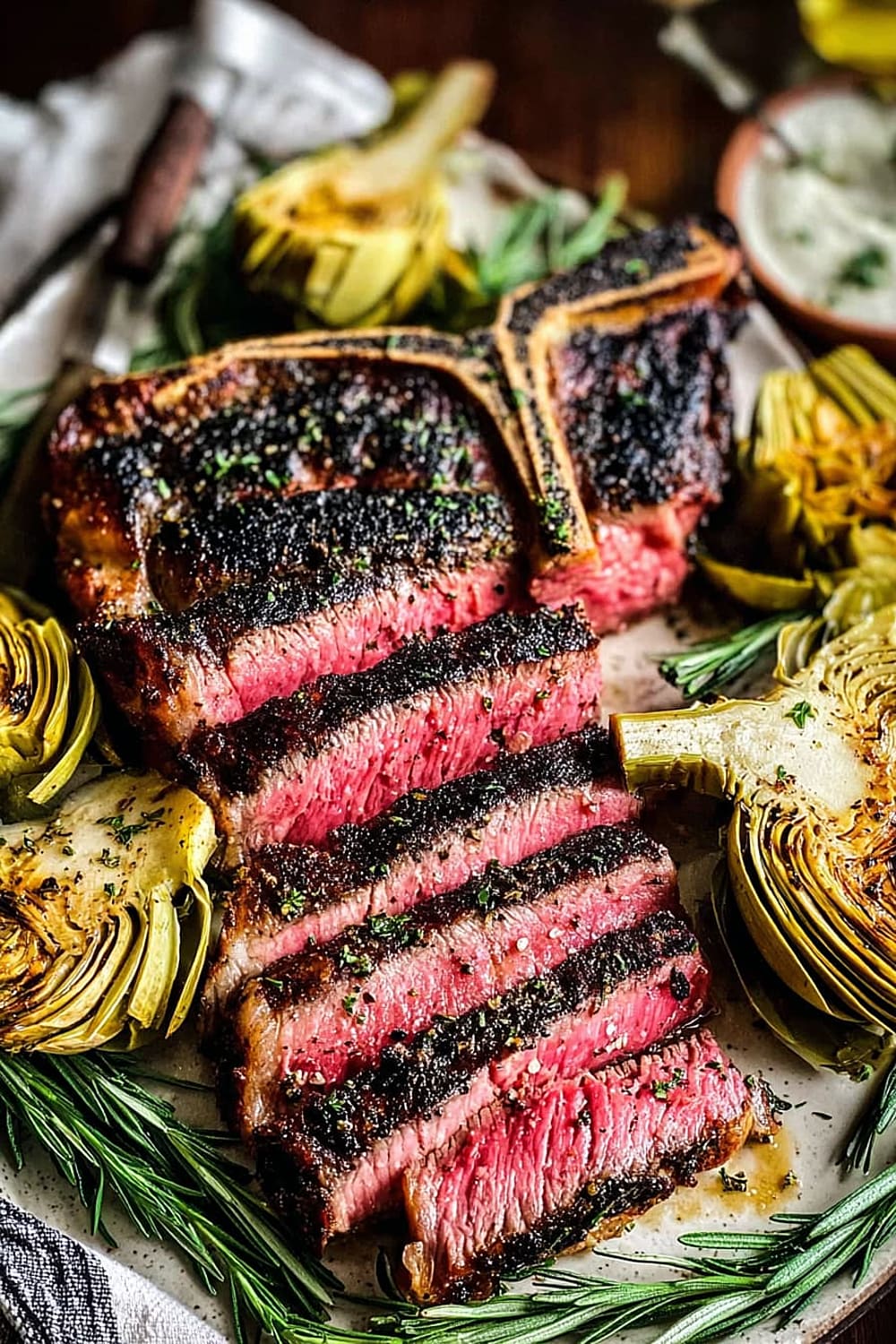
Fair warning: making this will result in people asking if you’ve been secretly attending culinary school, when really you just followed directions and didn’t panic.
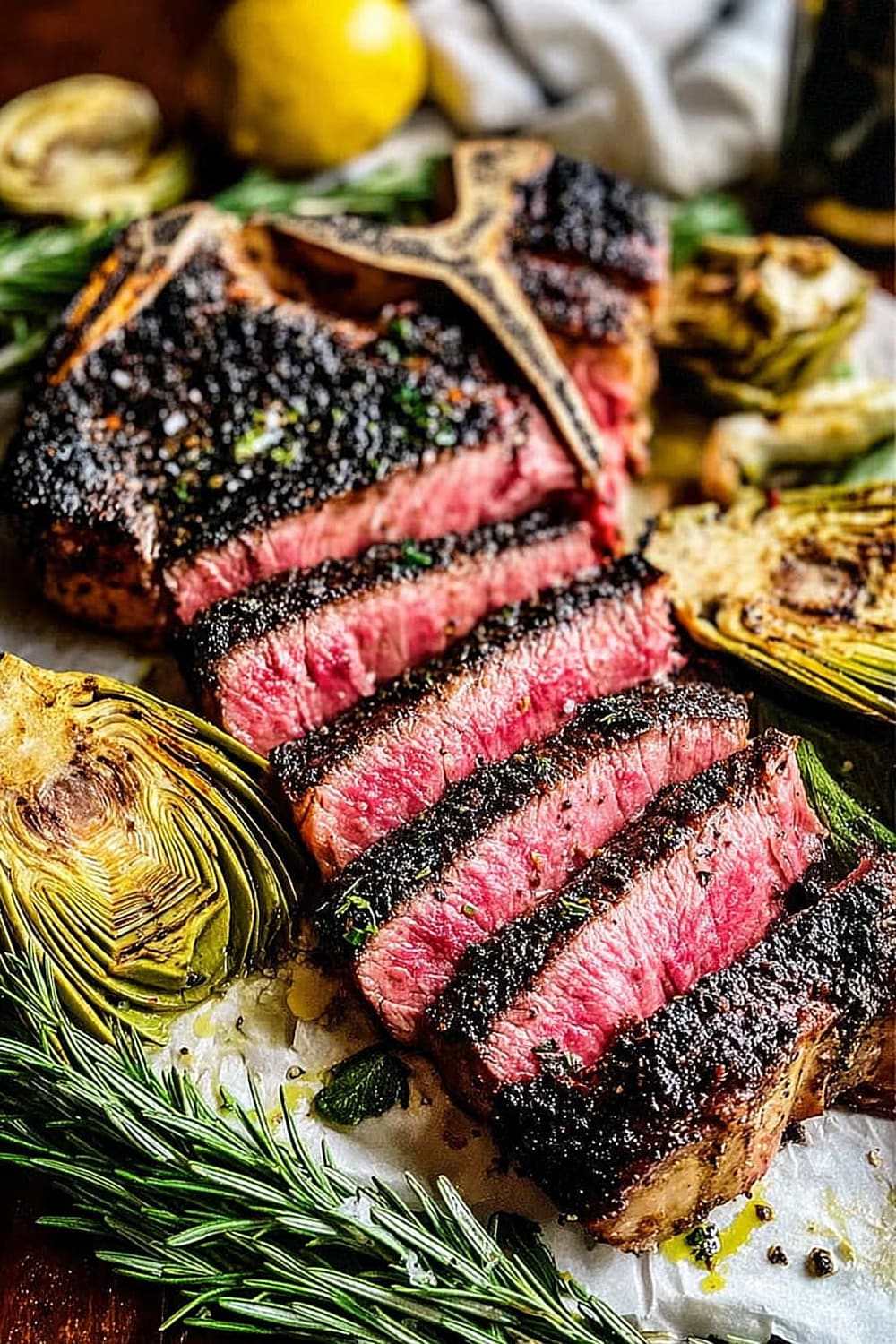
This is the kind of recipe that makes you feel like a grill master, even if your previous cooking experience peaked at not burning frozen pizza.
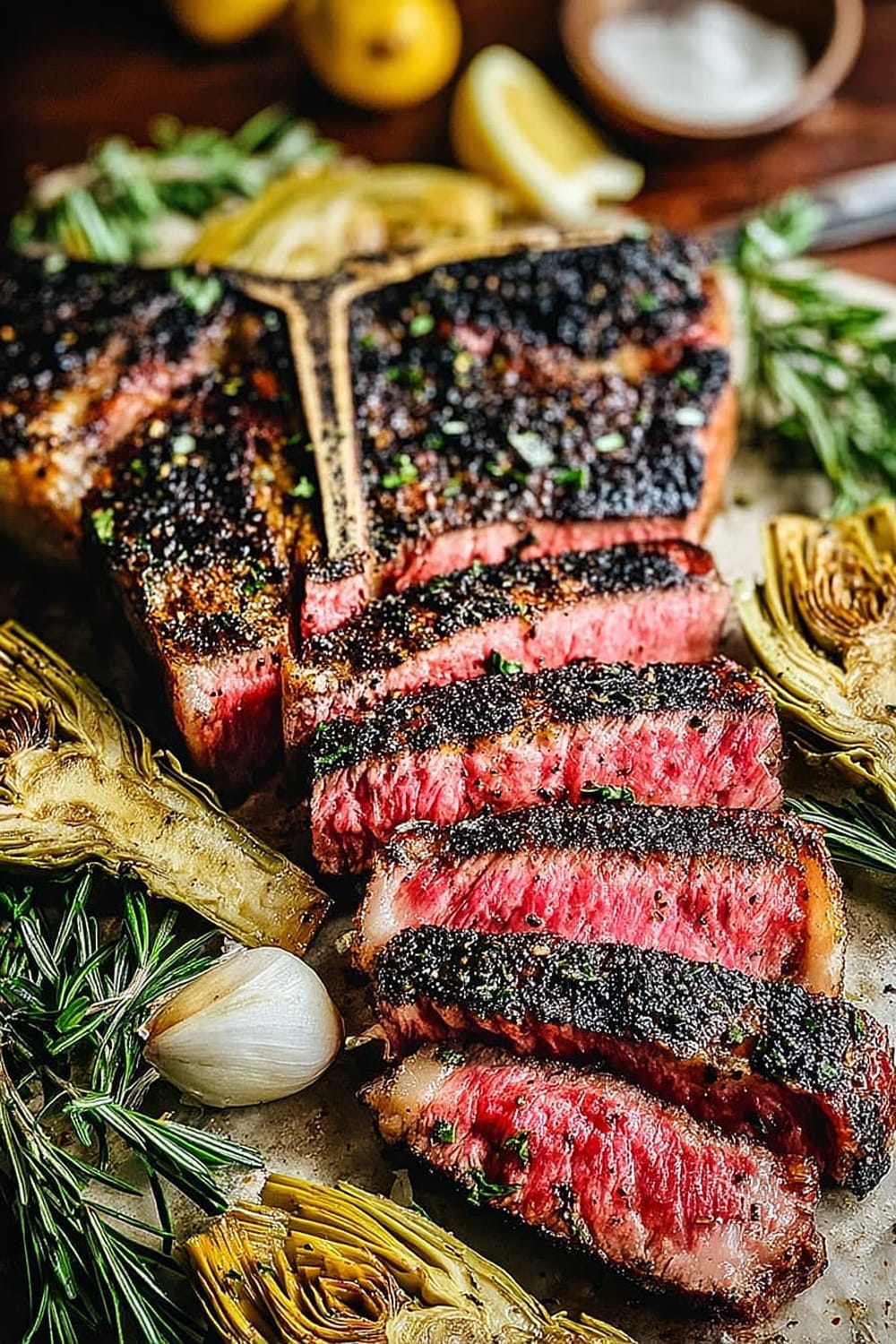
Ingredients
For the Steak
- 1 (32 oz) porterhouse steak
For the Marinade
- ¾ cup olive oil (extra virgin preferred)
- 1 tablespoon balsamic vinegar
- 1 large lemon (zest and juice)
- 3 cloves garlic, chopped
- 2 tablespoons fresh oregano, chopped
- 2 tablespoons fresh rosemary, chopped
- 1 tablespoon coarse sea salt
- 1 teaspoon fresh ground black pepper
- ½ teaspoon red pepper flakes (optional)
Instructions
Prepare the Marinade
- 1 In a large mixing bowl, combine ¾ cup olive oil, 1 tablespoon balsamic vinegar, lemon zest and juice from 1 large lemon, 3 chopped garlic cloves, 2 tablespoons fresh oregano, 2 tablespoons fresh rosemary, 1 tablespoon coarse sea salt, 1 teaspoon fresh ground black pepper, and ½ teaspoon red pepper flakes if using. Whisk everything together until well combined and emulsified.
- 2 Reserve ¼ cup of the prepared marinade in a small bowl and leave it at room temperature until needed for finishing. This reserved portion will add a bright, fresh flavor burst when drizzled over the cooked steak.
Marinate the Steak
- 3 Place the 32 oz porterhouse steak in a large sealable plastic bag and pour the remaining marinade over the steak. Remove as much air as possible while sealing the bag, pressing out any pockets that could prevent even marination.
- 4 Massage the marinade into the steak through the bag, ensuring every surface is evenly coated with the herb mixture. Place the sealed bag on a plate and refrigerate for 4 to 6 hours, allowing the Mediterranean flavors to penetrate the meat fibers.
Prepare for Grilling
- 5 Remove the steak from refrigeration and allow it to come closer to room temperature for about 1 hour. This ensures even cooking throughout. While the steak is tempering, light your grill and set it up for two-zone cooking, establishing an indirect heat zone at 225°F (107°C) as indicated by a reliable leave-in thermometer.
- 6 Clean and oil your grill grates thoroughly to prevent sticking. The porterhouse’s high fat content can cause flare-ups, so having clean grates is essential for achieving those perfect grill marks.
Low and Slow Phase
- 7 Place the steak on the grill over the indirect heat zone, positioning the filet side (the smaller, more tender portion) away from the direct heat source. This protects the delicate filet from overcooking while the strip side handles the initial heat.
- 8 Close the lid and allow the steak to slowly reach an internal temperature of 100°F (38°C) in the thickest part. This reverse-sear method ensures even cooking throughout and takes approximately 20-25 minutes.
High-Heat Searing
- 9 Once the internal temperature reaches 100°F (38°C), remove the steak and stoke the coals or increase gas heat to create maximum heat on the direct side of your grill. You want the hottest possible surface for the final sear.
- 10 Place the steak directly over the hot coals or high heat zone. Turn the steak every 20 seconds, creating an even crust on all surfaces. Continue this process until a beautiful, caramelized crust forms and the internal temperature reaches 127°F (53°C) for perfect medium-rare doneness.
Rest and Serve
- 11 Remove the steak from the grill and immediately drizzle with the reserved marinade for a fresh herb finish. Allow the steak to rest for 5 minutes before slicing, which redistributes the juices throughout the meat for maximum tenderness.
- 12 Slice against the grain and serve family-style on a large cutting board or platter, allowing everyone to enjoy both the strip and filet portions of this magnificent cut.
Recommended Equipment and Kitchen Tools
Essential Grilling Tools (for best results)
- Cast iron grill grates – Retain heat better than standard grates and create superior sear marks on your porterhouse
- Instant-read thermometer – Critical for monitoring internal temperature during the reverse-sear process
- Long-handled tongs – Keep your hands safely away from high heat while turning the steak every 20 seconds
- Grill brush – Clean grates prevent sticking and ensure beautiful presentation
Helpful Upgrades
- Digital probe thermometer – Allows continuous monitoring without opening the grill lid, maintaining consistent temperature
- Silicone basting brush – Perfect for applying the reserved marinade without absorbing flavors like natural bristles
- Large cutting board – Bamboo or hardwood boards provide stable surfaces for slicing this substantial cut
- Sharp carving knife – A quality blade ensures clean cuts that preserve the steak’s juices
Nice-to-Have Options
Grill mat or aluminum foil – Creates a barrier for the indirect cooking phase while still allowing smoke flavor
Meat claws – Helpful for handling and positioning this large, heavy cut safely on the grill
Kitchen scale – Ensures accurate marinade proportions for consistent results every time
Remember, these tools enhance your cooking experience but aren’t mandatory – great technique matters more than expensive equipment!
Recipe Variations and Dietary Modifications
Herb Variations
- Mediterranean blend → Replace oregano and rosemary with fresh thyme, basil, and marjoram for a different Italian profile
- French-inspired → Use fresh tarragon, chives, and parsley with a splash of white wine vinegar instead of balsamic
- Spanish twist → Add smoked paprika and fresh cilantro to the marinade for Iberian flavors
Heat Level Adjustments
- Mild version → Omit red pepper flakes and reduce black pepper to ½ teaspoon
- Spicy upgrade → Add 1 minced jalapeño or ½ teaspoon cayenne pepper to the marinade
- Smoky heat → Include 1 teaspoon chipotle powder for complex, smoky spice
Cooking Method Alternatives
- Oven method → Reverse-sear in 225°F oven until 100°F internal, then sear in screaming hot cast iron skillet
- Pan-seared version → Use a large cast iron skillet for stovetop cooking when grilling isn’t possible
- Sous vide adaptation → Cook at 129°F for 2 hours, then sear for 1 minute per side for ultimate precision
Marinade Modifications
- Wine-based → Replace half the olive oil with dry red wine for deeper flavor complexity
- Citrus variations → Try lime or orange zest instead of lemon for different brightness profiles
- Vinegar alternatives → White wine vinegar or red wine vinegar work beautifully in place of balsamic
Nutritional Information and Health Benefits
Key Nutritional Highlights
This porterhouse steak provides approximately 650-700 calories per 8 oz serving, making it a protein-rich centerpiece for any meal. The cut delivers an impressive 50-55 grams of high-quality complete protein, containing all essential amino acids your body needs for muscle maintenance and repair. The olive oil-based marinade contributes healthy monounsaturated fats while keeping saturated fat content reasonable at around 15-18 grams per serving.
Health Benefits of Main Ingredients
The grass-fed beef in porterhouse steak provides exceptional amounts of iron, zinc, and vitamin B12, essential for energy production and immune function. Extra virgin olive oil delivers powerful antioxidants and anti-inflammatory compounds that support heart health. Fresh garlic contains allicin, known for its cardiovascular benefits and immune-boosting properties. The fresh herbs – oregano and rosemary – are rich in antioxidants and have natural antimicrobial properties, while lemon provides vitamin C and helps with iron absorption from the beef.
Dietary Considerations
This recipe is naturally gluten-free, dairy-free, and keto-friendly, making it suitable for various dietary approaches. The high protein content makes it excellent for those following high-protein or low-carb lifestyles. Each serving provides virtually zero carbohydrates while delivering substantial protein and healthy fats. The marinade adds minimal calories while maximizing flavor and nutritional benefits from the herb and citrus components.
Smart Swaps and Ingredient Substitutions
Oil Substitutions:
- Olive oil → Avocado oil (1:1 ratio) for higher smoke point and neutral flavor
- Budget-friendly option → Quality vegetable oil mixed with 2 tablespoons olive oil for flavor
- Flavor variation → Half olive oil, half melted butter for richer taste
Herb Alternatives:
- Fresh oregano → 1 tablespoon dried oregano (reduce by half when using dried herbs)
- Fresh rosemary → Fresh thyme or sage in equal amounts for different Mediterranean flavors
- Emergency substitution → 2 tablespoons Italian seasoning blend when fresh herbs aren’t available
Acid Component Swaps:
- Balsamic vinegar → Red wine vinegar or white wine vinegar (1:1 ratio)
- Lemon juice → Lime juice or white wine for different brightness profiles
- Citrus-free option → Additional tablespoon of vinegar plus 1 teaspoon sugar
Pantry Emergency Substitutions:
- Fresh garlic → 1 tablespoon garlic powder or granulated garlic
- Coarse sea salt → Kosher salt or table salt (reduce to 2 teaspoons)
- Fresh ground pepper → Pre-ground black pepper works fine, just use slightly less
Pro Tips for Substitutions:
- When using dried herbs, add them to the marinade 30 minutes early to rehydrate
- Store leftover marinade in refrigerator for up to 1 week for quick weeknight meals
- Double the recipe and freeze half the marinade in ice cube trays for future use
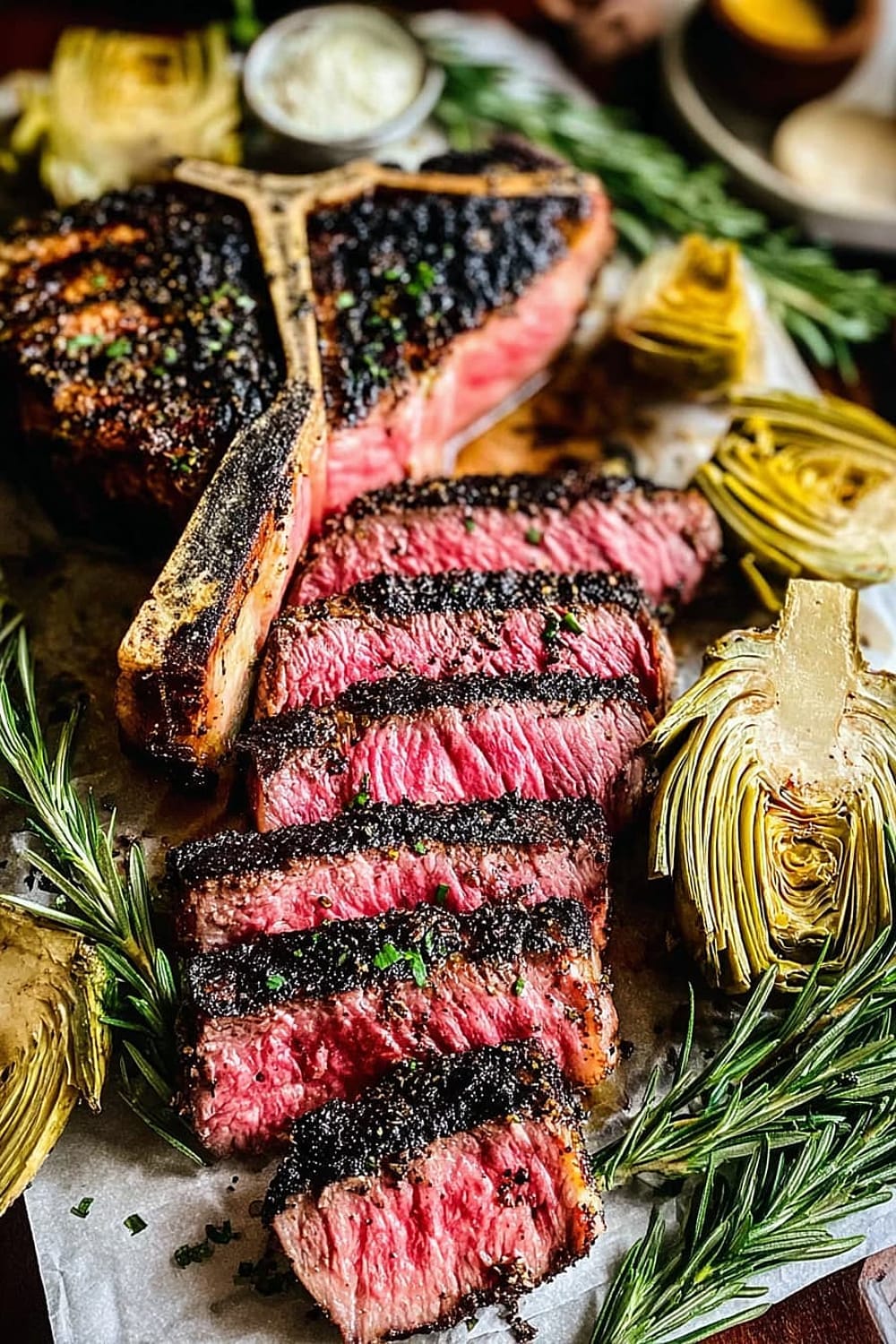
Make It Diabetes-Friendly
Carb Content Analysis:
- Original recipe: Less than 2g net carbs per serving from herbs and aromatics
- Already diabetes-friendly: This recipe naturally contains virtually no carbohydrates
- Blood sugar impact: Minimal due to high protein and fat content
Portion Control Strategies:
- Recommended serving: 6-8 oz portion instead of full quarter of the steak
- Protein benefits: High protein content helps stabilize blood sugar levels
- Satiety factor: Rich protein and fat content promotes longer-lasting fullness
Pairing for Blood Sugar Control:
- Vegetable additions: Serve with grilled low-carb vegetables like asparagus, zucchini, or bell peppers
- Fiber boost: Add a side salad with olive oil dressing to slow digestion
- Healthy fats: The olive oil marinade provides beneficial fats that help moderate blood sugar response
Timing and Preparation Tips:
- Pre-meal planning: The high protein content makes this ideal for steady energy
- Meal timing: Best consumed as part of a balanced meal rather than alone
- Leftover strategy: Slice thin for salads or low-carb wraps throughout the week
Total Health Impact: This recipe supports stable blood sugar levels while providing essential nutrients and satisfying protein that helps prevent overeating later.
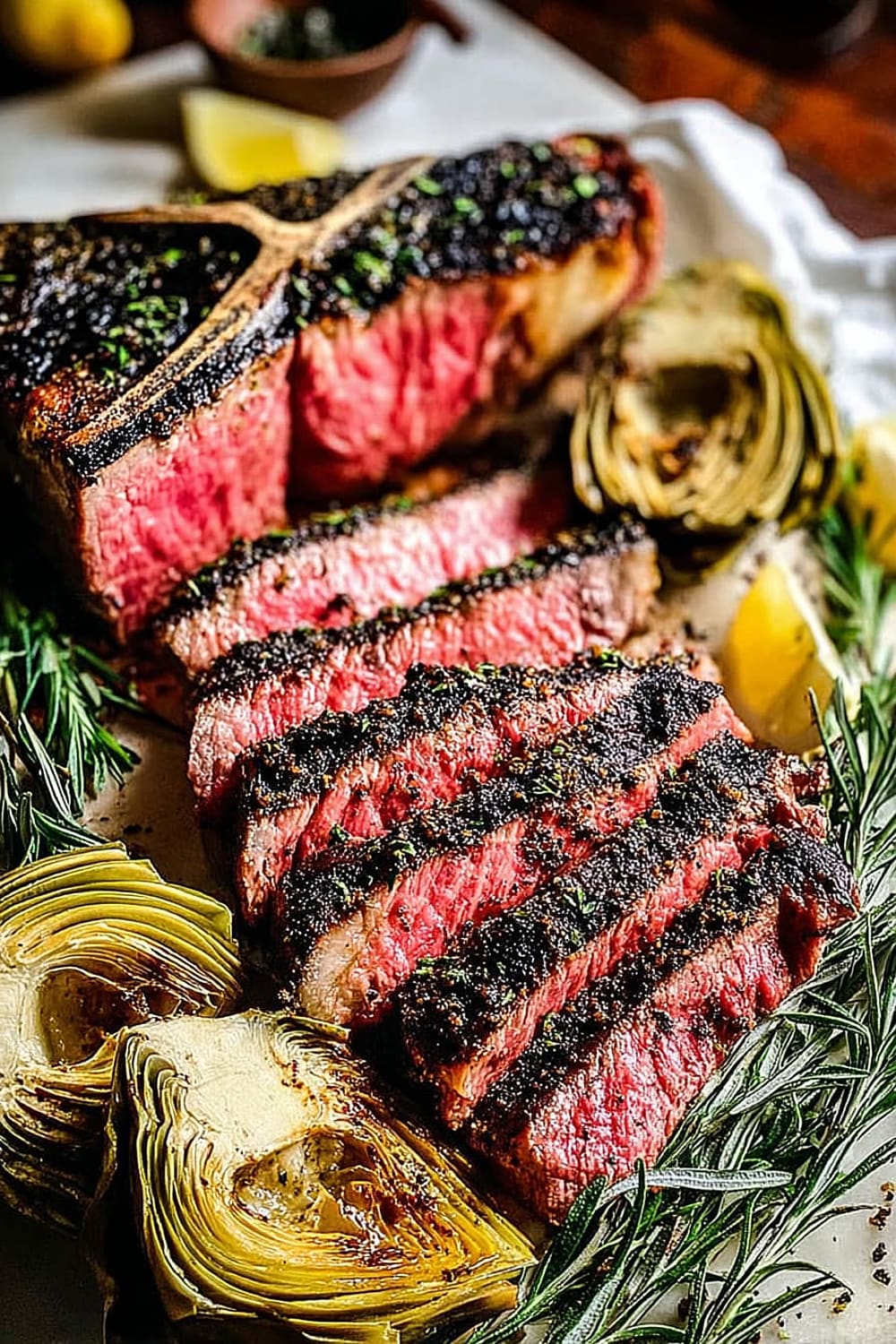
Perfect Pairing Suggestions
Wine Pairings
The robust flavors of this Tuscan-style porterhouse pair beautifully with bold red wines like Chianti Classico, Brunello di Montalcino, or Barolo. For non-Italian options, try Cabernet Sauvignon or Malbec with enough tannins to complement the rich meat. Sangiovese specifically echoes the Tuscan theme while providing the perfect acidic balance to cut through the steak’s richness.
Side Dish Recommendations
Grilled vegetables like zucchini, eggplant, and red peppers continue the Mediterranean theme while providing color contrast. Roasted garlic mashed potatoes or herb-crusted potatoes complement the steak’s bold flavors without competing. Sautéed spinach with garlic or arugula salad with lemon vinaigrette adds fresh, peppery notes that brighten the rich meat. Grilled asparagus or roasted Brussels sprouts provide textural contrast and earthy flavors.
Complete Meal Ideas
Start with bruschetta or antipasto to establish the Italian theme. Follow with the porterhouse as the centerpiece, accompanied by risotto or polenta for authentic Italian comfort. Finish with tiramisu or panna cotta for a restaurant-quality experience at home.
Occasion Suggestions
This impressive cut shines at dinner parties, anniversary celebrations, or weekend entertaining when you want to create a memorable experience. The dramatic presentation makes it perfect for Father’s Day, birthday celebrations, or any time you want to showcase serious grilling skills.
Pro Tips and Troubleshooting
Temperature Mastery
Always use a reliable instant-read thermometer inserted into the thickest part of the strip side for accurate readings. The filet side cooks faster, so monitoring the strip ensures even doneness throughout. If your steak is cooking too quickly during the low-temperature phase, move it further from the heat source or reduce grill temperature to 200°F (93°C).
Common Mistakes and Solutions
Flare-up prevention: Keep a spray bottle of water nearby for minor flare-ups, but avoid dousing the steak directly. Uneven cooking: If one side is cooking faster, rotate the steak 180 degrees during the indirect cooking phase. Tough texture: Never skip the resting period – it’s crucial for redistributing juices throughout the meat fibers.
Make-Ahead Strategies
Marinate the steak up to 24 hours in advance for deeper flavor penetration. The marinade can be prepared 3 days ahead and stored in the refrigerator. For entertaining, complete the indirect cooking phase earlier in the day, then finish with the high-heat sear just before serving.
Storage and Reheating
Store leftover steak wrapped tightly in refrigerator for up to 3 days. For reheating, slice thin and warm gently in a skillet with a splash of beef broth to prevent drying. Cold leftover steak makes excellent salad protein or sandwich filling.
Scaling Tips
This recipe easily doubles for larger gatherings – just ensure your grill has adequate space for proper heat zones. When cooking multiple steaks, stagger the start times by 5-10 minutes to manage the final searing phase effectively.
The beauty of this Tuscan-style porterhouse lies in its perfect balance of rustic simplicity and sophisticated technique, proving that the best meals often come from treating quality ingredients with respect and patience. Whether you’re celebrating a special occasion or just elevating a weekend dinner, this recipe delivers restaurant-quality results that’ll have everyone asking for your secret – and now you have one worth sharing.